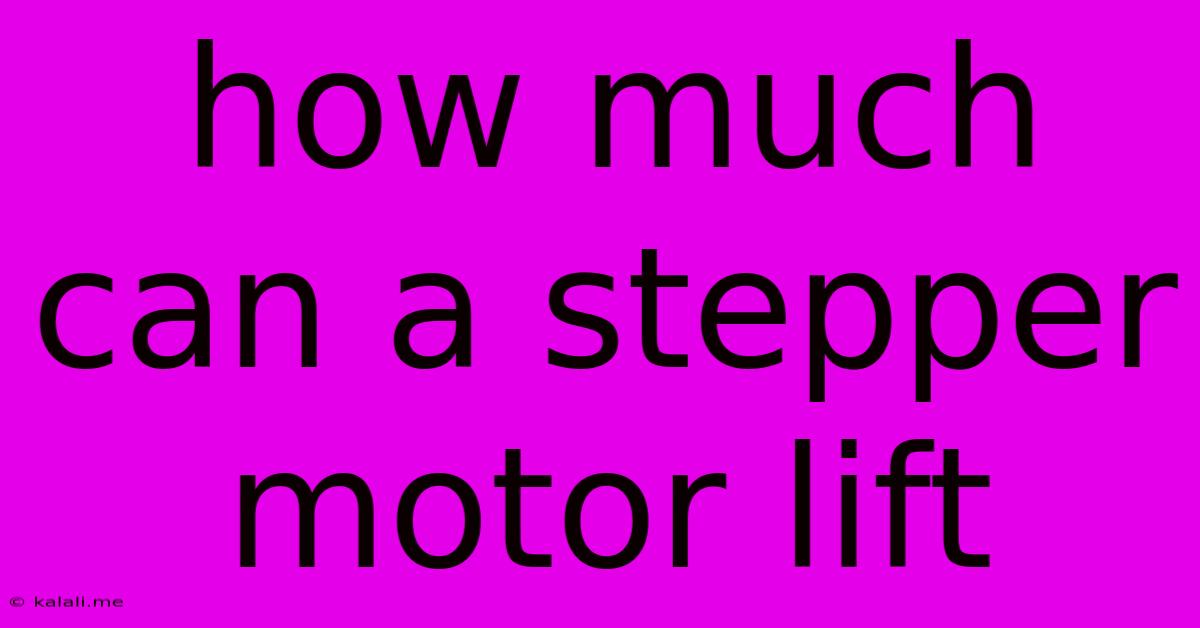How Much Can A Stepper Motor Lift
Kalali
May 23, 2025 · 3 min read

Table of Contents
How Much Can a Stepper Motor Lift? A Comprehensive Guide
Meta Description: Discover the factors influencing a stepper motor's lifting capacity, including torque, gearing, and motor type. Learn how to calculate lifting power and choose the right motor for your application.
Determining the exact weight a stepper motor can lift isn't a simple matter of looking at a spec sheet. While manufacturers provide crucial data like holding torque, the actual lifting capacity depends on several interconnected factors. This guide explores these factors and empowers you to estimate the lifting capabilities of your stepper motor system.
Understanding Key Factors Affecting Lifting Capacity
Several crucial elements determine how much weight a stepper motor can successfully lift:
-
Holding Torque: This is the most significant specification. Holding torque represents the motor's ability to resist rotational movement when stationary. It's usually measured in Newton-meters (Nm) or ounce-inches (oz-in). Higher holding torque generally translates to a greater lifting capacity.
-
Gearing: Gearboxes are often used to increase the motor's torque at the expense of speed. A high-gear-ratio gearbox can significantly amplify the stepper motor's lifting power. The gear ratio is expressed as the ratio of the output shaft speed to the input shaft speed. A higher gear ratio means more torque but slower movement.
-
Mechanical Advantage: This refers to the leverage provided by the system's mechanical components, such as pulleys, levers, or screws. A well-designed mechanical system can significantly boost the lifting capacity of even a relatively low-torque stepper motor. For example, a system with a pulley system will provide mechanical advantage.
-
Motor Type: Different stepper motor types (e.g., NEMA 17, NEMA 23) possess varying torque capabilities. Larger motors generally have higher torque ratings. The physical size and construction directly influence the motor's ability to generate torque.
-
Duty Cycle: The duty cycle describes the percentage of time the motor operates under load. Continuous operation at maximum torque will lead to overheating and potentially damage the motor. Operating within the specified duty cycle ensures reliable performance and extends the motor's lifespan. Sustained lifting capacity will be lower if the motor is working at a high duty cycle.
-
Friction: Friction in the mechanical system (e.g., bearings, guides) will reduce the effective lifting capacity. Minimizing friction through proper lubrication and design is vital for optimal performance.
Calculating Lifting Capacity: An Approximated Approach
Precise calculation requires detailed knowledge of your specific system and the motor's performance curves. However, a rough estimation can be made using the following simplified formula:
Lifting Capacity (Weight) ≈ Holding Torque × Mechanical Advantage / Radius of the Lifting Mechanism
This formula assumes negligible friction and other losses. The radius of the lifting mechanism is the distance from the center of rotation to the point where the load is applied. This is usually expressed in meters. Remember to convert all units to a consistent system (e.g., SI units).
Choosing the Right Stepper Motor for Your Lifting Application
Selecting an appropriate stepper motor involves careful consideration of:
-
Required Lifting Weight: Determine the maximum weight you need to lift.
-
Lifting Speed: Consider the desired speed of lifting. Higher speeds usually require motors with lower torque and vice-versa.
-
Available Space: The physical dimensions of the motor and associated components need to fit your application.
-
Budget: Stepper motors vary significantly in price, impacting the overall cost of your project.
By understanding the factors influencing lifting capacity and utilizing the approximate calculation formula, you can make informed decisions when selecting a stepper motor for your lifting application. Remember that this is an estimation; thorough testing and safety measures are crucial for any project involving lifting mechanisms. Always consult the manufacturer's specifications for detailed performance data.
Latest Posts
Latest Posts
-
Marlin Ho0w To Get Cr Touch To Probe In Grid
May 23, 2025
-
Can Thunderbolt 2 Go To Usb 3 0 Micro B
May 23, 2025
-
Refrigerator Is Cold But Freezer Is Not Freezing
May 23, 2025
-
Can You Paint Enamel Over Latex
May 23, 2025
-
The Operation Cant Be Completed One Or More Req
May 23, 2025
Related Post
Thank you for visiting our website which covers about How Much Can A Stepper Motor Lift . We hope the information provided has been useful to you. Feel free to contact us if you have any questions or need further assistance. See you next time and don't miss to bookmark.